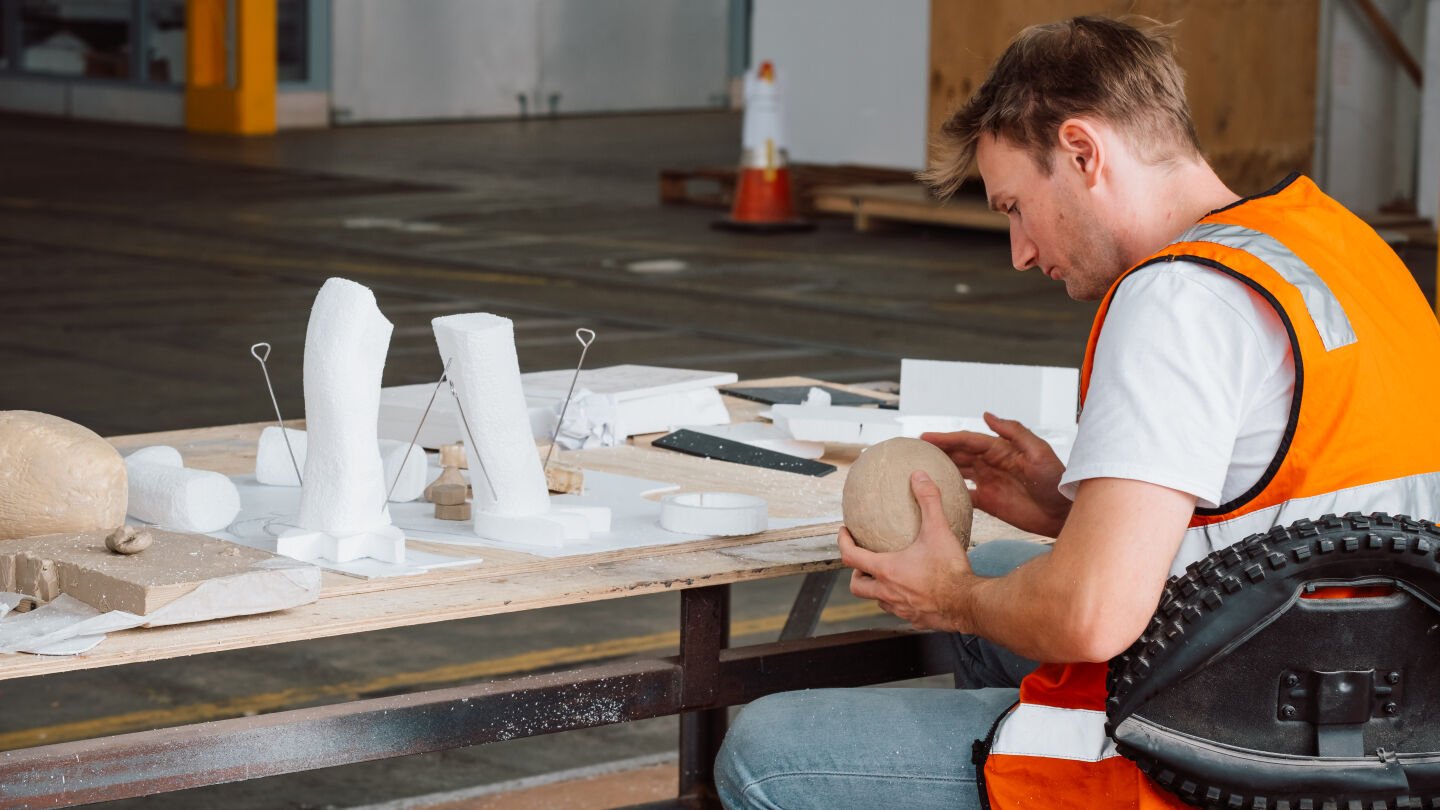Contemporary Art, Material Exploration and Transformations
A Look at Tom Keukenmeester's Residency at our Brisbane Workshop

Tom Keukenmeester, a contemporary Australian artist born in Adelaide, has gained recognition for his figurative art, which encompasses traditional oil painting and ceramic sculpture. In his work, Keukenmeester draws inspiration from art history while intertwining contemporary societal and personal narratives.
Recently, he embarked on a residency at UAP (Urban Art Projects) in Brisbane, where he explored new artistic horizons and translated his ceramic sculptures into bronze. In this interview, UAP Principal Daniel Clifford connects with Keukenmeester to discuss his artistic process, experiences at the residency, and how it has influenced his future aspirations.

(Daniel Clifford) (DC) Can you tell us how you start the process of making? What is the genesis for the commencement of the figures?
(Tom Keukenmeester) (TK) My figures usually draw inspiration from historic depictions I encounter daily, such as museums, online sources, or archival records. These references serve as the genesis for the idea or concept. However, I rarely refer to any images once I begin making a figure. Instead, I rely on intuition and abstraction to create a form that evokes the desired emotional response. For my bronze work at UAP, I wanted to play with the concept of idolatry in a truly secular society, subverting the traditional notion of immortalizing figures of authority.
(DC) You studied art history, and it often informs your work. Is there a particular period that intrigues you and why?
(TK) My fascination with different periods in art history has evolved over time. Previously, I've drawn inspiration from the work of Goya for his bold commentary, brilliant compositions, and technical ability to connect historical parallels to the present. However, I also find power in studying more ancient times, like the Upper Paleolithic era, with its crude and shorthand abstractions of form. Recently, I've become obsessed with more modern work, such as the sculptures of Rodin. These periods may not be directly linked, but they each offer unique insights that inspire my artistic journey.
(DC) What were the main goals or objectives you set for yourself at the beginning of the residency, and did you achieve them? Why or why not?
(TK) My primary objective was to translate my ceramic sculptural practice into bronze and gain a deeper understanding of the nuances of working with this medium. Additionally, I aimed to create new artwork for Sydney Contemporary this year. I am pleased to say that I have achieved these goals during the residency.




(DC) Working with UAP, you investigated translating your work from ceramics. How did you find that journey, and what discoveries did you make?
(TK) The journey of translating my work from ceramics to other materials, such as polystyrene and plasticine, presented certain considerations that I hadn't considered, particularly regarding pattern making. Each material has its strengths and weaknesses, and it required a learning curve to recreate my aesthetic using new materials. I also delved into conversations about scaling up work and exploring 3D scanning/printing. I discovered that while these methods have advantages, they are not without complexities.
(DC) How did the residency environment and the presence of makers and craftspeople influence your work?
(TK) It was an incredible experience working alongside highly knowledgeable and passionate makers at UAP. The residency environment presented both challenges and opportunities. Coming from my familiar studio space, I had to adapt to new materials and equipment, which enhanced my understanding and skills. The presence of craftspeople who excel in their craft inspired me to push the boundaries of my work.
(DC) Did your work undergo any significant changes or evolution during your residency? If yes, in what ways did the residency contribute to this transformation?
(TK) The introduction of materials like polystyrene and plasticine liberated my forms from the structural limitations of clay. For instance, clay figures need to be hollow and dry evenly, making it challenging to extend limbs without additional support. Plasticine, on the other hand, offers greater flexibility and possibilities. This transformation allowed me to envision using plasticine for other projects, including open-air moulding. The residency at UAP provided a new perspective and expanded my creative repertoire.
(DC) What are your future plans or aspirations as an artist, and how do you see the residency influencing your artistic trajectory moving forward?
(TK) My future plans involve creating larger works and expanding into the public realm. The residency at UAP has shown me clear pathways to achieve these aspirations. By learning what is possible at UAP, I can now think bigger and explore how my work can extend beyond its current form. UAP and I are collaborating on a bronze sculpture for presentation at Sydney Contemporary. I hope this endeavour is successful, as it will pave the way for even grander projects in the future.
As Tom Keukenmeester continues to explore the intersection of art history, contemporary narratives, and material transformations, his time at UAP's Brisbane workshop and residency has undoubtedly impacted his artistic practice. With a newfound understanding of bronze and expanded possibilities with different materials, Tom's artistic trajectory is set to reach new heights as he creates more significant works and extends his artistic vision to the public realm.
#Related Articles

Jarni McGuire's Goodjal ba Ngoonii Koorndaam
Noongar artist Jarni McGuire's work for Brookfield Place's One the Esplanade in Perth illuminates cultural heritage that speaks to place, coming together, and celebration.

Lindy Lee: Ouroboros
Lindy Lee's Ouroboros is taking shape. Our team in Brisbane is working hard to realise Lindy's vision to create her first immersive public sculpture for the National Gallery of Australia's forecourt.

How Integrated Artwork Transforms Property into Living Narrative
The Urban Developer Article Feature
By Michael Miscamble, Senior Associate | Specialty Architecture and Design, UAP | Urban Art Projects
News




